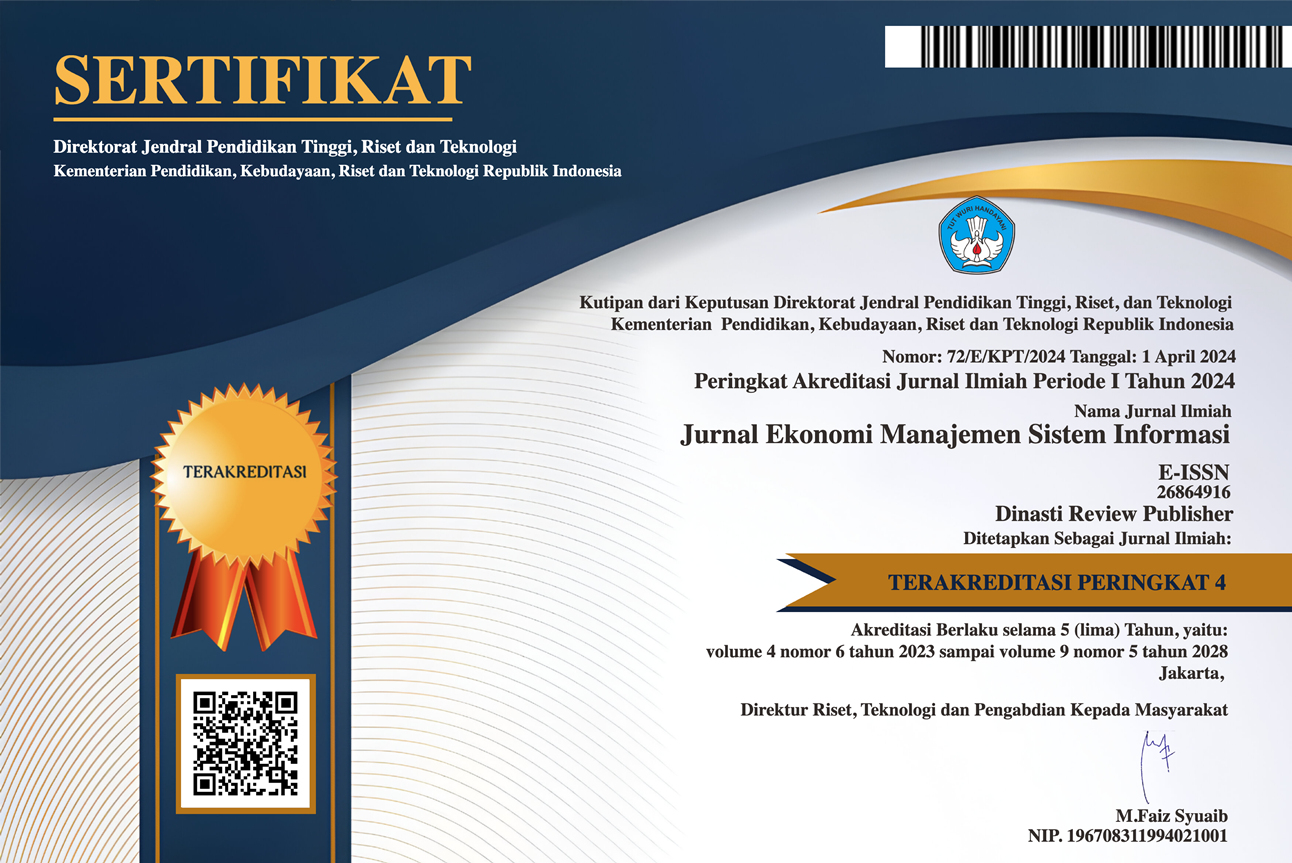Penerimaan Nasabah Bank Nagari Terhadap Penggunaan Aplikasi Ollin Berdasarkan Model UTAUT
DOI:
https://doi.org/10.38035/jemsi.v5i6.2686Keywords:
Nasabah Bank Nagari, Aplikasi Ollin, Model UTAUT.Abstract
Penelitian ini bertujuan untuk menguji pengaruh performance expectancy pada use behavior Ollin nasabah Bank Nagari, pengaruh effort expectancy pada use behavior Ollin nasabah Bank Nagari, pengaruh social influence pada use behavior Ollin nasabah Bank Nagari, pengaruh facilitating condition pada use behavior Ollin nasabah Bank Nagari, pengaruh hedonic motivation pada use behavior Ollin nasabah Bank Nagari, pengaruh perceived value pada use behavior Ollin nasabah Bank Nagari, pengaruh habit pada use behavior Ollin nasabah bank nagari, pengaruh risk perception pada use behavior Ollin nasabah Bank Nagari, pengaruh use behavior Ollin Bank Nagari pada user saticfaction nasabah Bank Nagari, dan pengaruh e-CRM Ollin pada user saticfaction nasabah Bank Nagari. Jenis penelitian yang digunakan dalam penelitian ini adalah explanatory research. Explanatory research adalah jenis penelitian yang dipergunakan untuk menjelaskan kedudukan antara variabel yang diteliti serta juga menjelaskan hubungan antara variabel yang satu dengan yang lain melalui pengujian hipotesis yang telah dirumuskan. Sedangkan metode penelitiannya adalah survey explanatory yang mengedepankan metode kuantitatif. Penelitian ini menggunakan pengujian hipotesis. Hasil penelitian ini adalah Sebaiknya pihak manajemen dapat meningkatkan kembali perilaku konsumen dalam menggunakan aplikasi Ollin yang akan berdapak kepada semakain menigktnya kepuasan nasabah dalam menggunakan aplikasi Ollin.
References
Al-Qeisi, K., Dennis, C., Alamanos, E., & Jayawardhena, C. (2014). Website design quality and usage behavior: Unified Theory of Acceptance and Use of Technology. Journal of Business Research, 67(11), 2282–2290.
Al-Saedi, K., Al-Emran, M., Abusham, E., & El Rahman, S. A. (2019). Mobile payment adoption: a systematic review of the UTAUT model. 2019 International Conference on Fourth Industrial Revolution (ICFIR), 1–5.
Alalwan, A. A., Rana, N. P., Dwivedi, Y. K., & Algharabat, R. (2017). Social media in marketing: A review and analysis of the existing literature. Telematics and Informatics, 34(7), 1177–1190.
Alfarano, C., Andrade, C. E., Anthony, K., Bahroos, N., Bajec, M., Bantoft, K., Betel, D., Bobechko, B., Boutilier, K., & Burgess, E. (2005). The biomolecular interaction network database and related tools 2005 update. Nucleic Acids Research, 33(suppl_1), D418–D424.
Alrajawy, I., Isaac, O., Ghosh, A., Nusari, M., Al-Shibami, A. H., & Ameen, A. A. (2018). Determinants of Student’s intention to use Mobile learning in Yemeni public universities: Extending the technology acceptance model (TAM) with anxiety. International Journal of Management and Human Science (IJMHS), 2(2), 1–9.
Amin, A., Almari, H., Isaac, O., & Mohammed, F. (2019). Investigating the key factors influencing the use of online social networks in public sector context in the UAE. International Journal of Innovation, 7(3), 392–411.
Amoroso, D. L., & Magnier-Watanabe, R. (2012). Building a research model for mobile wallet consumer adoption: the case of mobile Suica in Japan. Journal of Theoretical and Applied Electronic Commerce Research, 7(1), 94–110.
André, P., Baccigalupi, C., Banday, A., Barbosa, D., Barreiro, B., Bartlett, J., Bartolo, N., Battistelli, E., Battye, R., & Bendo, G. (2014). PRISM (Polarized Radiation Imaging and Spectroscopy Mission): an extended white paper. Journal of Cosmology and Astroparticle Physics, 2014(02), 6.
Anjana, R. M., Pradeepa, R., Deepa, M., Datta, M., Sudha, V., Unnikrishnan, R., Bhansali, A., Joshi, S. R., Joshi, P. P., & Yajnik, C. S. (2011). Prevalence of diabetes and prediabetes (impaired fasting glucose and/or impaired glucose tolerance) in urban and rural India: Phase I results of the Indian Council of Medical Research–INdia DIABetes (ICMR–INDIAB) study. Diabetologia, 54(12), 3022–3027.
Arikunto, S. (2010). Metode peneltian. Jakarta: Rineka Cipta.
Atarwaman, R. J. D. (2022). Pengaruh Persepsi Resiko, Kegunaan, Kepercayaan Dan Kemudahan Terhadap Sikap Penggunaan Mobile Banking Di Kota Ambon. E-QIEN Jurnal Ekonomi Dan Bisnis, 10(2), 281–290.
Ayaz, A., & Yanarta?, M. (2020). An analysis on the unified theory of acceptance and use of technology theory (UTAUT): Acceptance of electronic document management system (EDMS). Computers in Human Behavior Reports, 2(March). https://doi.org/10.1016/j.chbr.2020.100032
Baptista, G., & Oliveira, T. (2016). A weight and a meta-analysis on mobile banking acceptance research. Computers in Human Behavior, 63, 480–489.
Barbosa, H. F., García-Fernández, J., Pedragosa, V., & Cepeda-Carrion, G. (2021). The use of fitness centre apps and its relation to customer satisfaction: a UTAUT2 perspective. International Journal of Sports Marketing and Sponsorship.
Boateng, R., Mbrokoh, A. S., Boateng, L., Senyo, P. K., & Ansong, E. (2016). Determinants of e-learning adoption among students of developing countries. The International Journal of Information and Learning Technology.
Bodet, G. (2006). Investigating customer satisfaction in a health club context by an application of the tetraclasse model. European Sport Management Quarterly, 6(2), 149–165.
Brown, S. A., & Venkatesh, V. (2005). Model of adoption of technology in households: A baseline model test and extension incorporating household life cycle. MIS Quarterly, 399–426.
Celik, H. (2016). Customer online shopping anxiety within the Unified Theory of Acceptance and Use Technology (UTAUT) framework. Asia Pacific Journal of Marketing and Logistics.
Çera, G., Pagria, I., Khan, K. A., & Muaremi, L. (2020). Mobile banking usage and gamification: the moderating effect of generational cohorts. Journal of Systems and Information Technology.
Chemingui, H., Mzali, J. C., Missaoui, T., Konyar, M., Smiri, M., Cengiz Yatmaz, H., & Hafiane, A. (2021). Characteristics of Er-doped zinc oxide layer: application in synthetic dye solution color removal. Sep. Purif. Technol, 209, 402–413.
Chen, H., Yuan, H., Gao, R., Zhang, J., Wang, D., Xiong, Y., Fan, G., Yang, F., Li, X., & Zhou, J. (2014). Clinical and epidemiological characteristics of a fatal case of avian influenza A H10N8 virus infection: a descriptive study. The Lancet, 383(9918), 714–721.
Cheng, M. L., Ling, D., Nanu, P. K. P., Nording, H., & Lim, C. H. (2015). Factors influencing late stage of breast cancer at presentation in a district Hospital-Segamat Hospital, Johor. Med J Malaysia, 70(3), 148–152.
Chiwara, J. R., Mjoli, T. Q., & Chinyamurindi, W. T. (2017). Factors that influence the use of the Internet for job-seeking purposes amongst a sample of final-year students in the Eastern Cape province of South Africa. SA Journal of Human Resource Management, 15(1), 1–9.
Chong, X., Fuchu, D. A. I., Xin, Y. A. O., Zhou, Z., & Jianzhang, X. (2010). GIS PLATFORM AND CERTAINTY FACTOR ANALYSIS METHOD BASED WENCHUAN EARTHQUAKE? INDUCED LANDSLIDE SUSCEPTIBILITY EVALUATION?. ??????, 18(1), 15.
Christasani, P. D., & Satibi, S. (2016). Kajian Faktor Demografi Terhadap Kepuasan Pasien Jaminan Kesehatan Nasional Pada Fasilitas Kesehatan Tingkat Pertama. Jurnal Farmasi Sains Dan Komunitas (Journal of Pharmaceutical Sciences and Community), 13(1), 28–34.
Curran, J. M., & Meuter, M. L. (2007). Encouraging existing customers to switch to self-service technologies: put a little fun in their lives. Journal of Marketing Theory and Practice, 15(4), 283–298.
Dezdar, S., & Ainin, S. (2011). The influence of organizational factors on successful ERP implementation. Management Decision.
Doody, R. S., Thomas, R. G., Farlow, M., Iwatsubo, T., Vellas, B., Joffe, S., Kieburtz, K., Raman, R., Sun, X., & Aisen, P. S. (2014). Phase 3 trials of solanezumab for mild-to-moderate Alzheimer’s disease. New England Journal of Medicine, 370(4), 311–321.
Escobar-Rodríguez, T., & Carvajal-Trujillo, E. (2014). Online purchasing tickets for low cost carriers: An application of the unified theory of acceptance and use of technology (UTAUT) model. Tourism Management, 43, 70–88.
Faaeq, M. K., Alqasa, K., & Al-Matari, E. M. (2014). Technology adoption and innovation of E-Government in Republic of Iraq. Asian Social Science, 11(3), 135–145.
Farah, M. F., Hasni, M. J. S., & Abbas, A. K. (2018). Mobile-banking adoption: empirical evidence from the banking sector in Pakistan. International Journal of Bank Marketing.
Farzin, M., Sadeghi, M., Kharkeshi, F. Y., Ruholahpur, H., & Fattahi, M. (2021). Extending UTAUT2 in M-banking adoption and actual use behavior: Does WOM communication matter? Asian Journal of Economics and Banking.
Fernandrez, F., & Pujani, V. (2019). Persepsi Nasabah Bank BCA Dalam Penggunaan Mobile Banking. JURNAL MANAJEMEN DAN BISNIS INDONESIA, 5(2), 165–180.
Glikson, E., Cheshin, A., & Kleef, G. A. van. (2018). The dark side of a smiley: Effects of smiling emoticons on virtual first impressions. Social Psychological and Personality Science, 9(5), 614–625.
Griffin, M. J., Abergel, A., Abreu, A., Ade, P. A. R., André, P., Augueres, J.-L., Babbedge, T., Bae, Y., Baillie, T., & Baluteau, J.-P. (2010). The Herschel-SPIRE instrument and its in-flight performance. Astronomy & Astrophysics, 518, L3.
Downloads
Published
How to Cite
Issue
Section
License
Copyright (c) 2024 Aqil Shidqii Rozaan, Alfitman Alfitman, Syafrizal Syafrizal

This work is licensed under a Creative Commons Attribution 4.0 International License.
Hak cipta :
Penulis yang mempublikasikan manuskripnya di jurnal ini menyetujui ketentuan berikut:
- Hak cipta pada setiap artikel adalah milik penulis.
- Penulis mengakui bahwa Jurnal Ekonomi Manajemen Sistem Informasi (JEMSI) berhak menjadi yang pertama menerbitkan dengan lisensi Creative Commons Attribution 4.0 International (Attribution 4.0 International CC BY 4.0) .
- Penulis dapat mengirimkan artikel secara terpisah, mengatur distribusi non-eksklusif manuskrip yang telah diterbitkan dalam jurnal ini ke versi lain (misalnya, dikirim ke repositori institusi penulis, publikasi ke dalam buku, dll.), dengan mengakui bahwa manuskrip telah diterbitkan pertama kali di Jurnal Ekonomi Manajemen Sistem Informasi (JEMSI).











































































